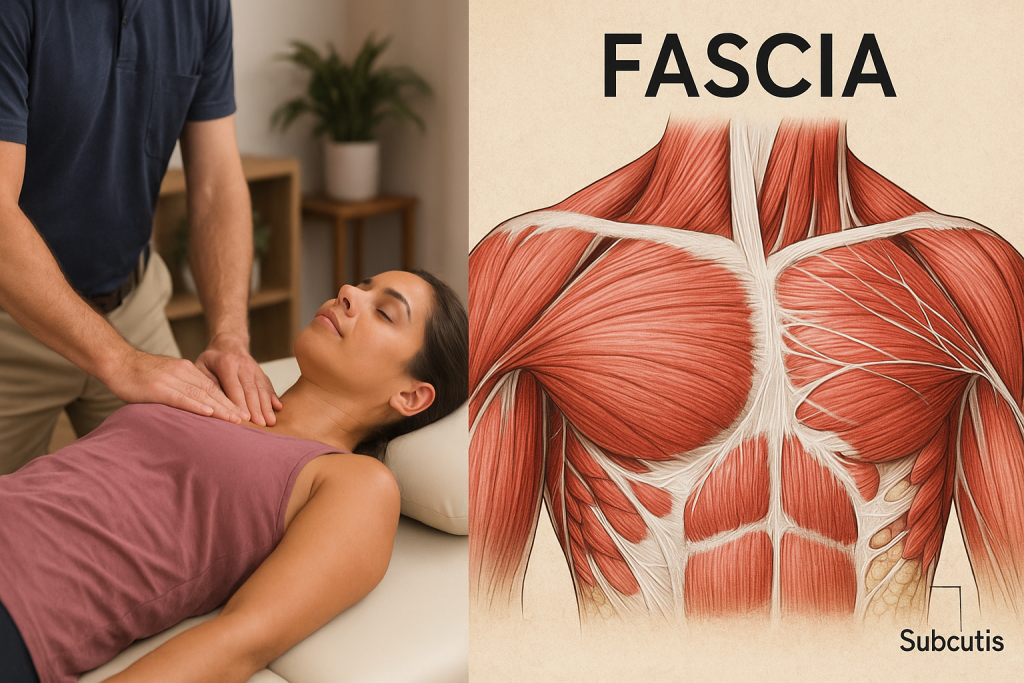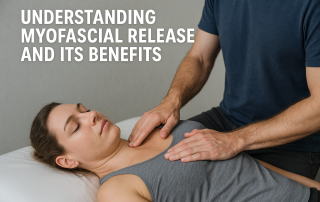Weight loss is rarely just about “eating less and moving more.”
Chronic pain, stress, poor sleep, old injuries, and limited mobility can all make it harder to exercise consistently or stay motivated with healthy habits.
That’s where myofascial release can fit into a more holistic weight loss plan. At Manual Therapy Associates in Arvada, we primarily use myofascial release to reduce pain, improve movement, and help your body feel safer and more comfortable being active. Those changes can indirectly support sustainable weight loss—without promising any miracle “fat-melting” shortcuts.
In this guide, we’ll walk through what myofascial release is, how it may support weight loss, and what you can expect if you schedule a session in our Arvada clinic.
What Is Myofascial Release?
Myofascial release (MFR) is a gentle, hands-on manual therapy that targets your fascia—the web of connective tissue surrounding and supporting your muscles, nerves, and organs. When fascia becomes tight or restricted from injury, stress, surgery, or poor posture, it can create trigger points and pain patterns that limit your movement.
During myofascial release, your therapist uses slow, sustained pressure and stretching to:
-
Reduce fascial restrictions and adhesions
-
Decrease muscle tension and pain
-
Improve circulation and tissue hydration
-
Restore more natural movement and alignment
Unlike a quick “deep tissue” massage, myofascial release is usually quieter, slower, and more focused on giving tissues enough time to soften and release.
Want a deeper dive into how fascia works?
Check out our blog: “Understanding Myofascial Release and Its Benefits.”
Can Myofascial Release Help With Weight Loss?
Let’s be clear upfront:
Myofascial release is not a direct fat-loss treatment. It doesn’t “burn calories” the way cardio does, and it won’t replace healthy nutrition or medical advice.
However, myofascial release can address several hidden obstacles that often derail weight loss, including pain, stiffness, stress, and poor recovery. By improving how your body feels and moves, it can make it easier to follow through on your exercise and self-care plans.
1. Pain relief so you can move more
Chronic pain—especially in the back, hips, knees, or neck—is one of the most common reasons people avoid exercise.
Myofascial restrictions can contribute to:
-
Aching, tight muscles
-
Painful trigger points that “refer” pain elsewhere
-
Compensations that overload other joints
By releasing those fascial restrictions, myofascial release can:
-
Decrease pain levels
-
Improve comfort with walking, strength training, or low-impact cardio
-
Help you tolerate longer or more frequent workouts
More comfortable movement can mean more consistent physical activity—one of the biggest drivers of sustainable weight loss.
2. Better mobility, posture, and exercise tolerance
Tight fascia can restrict how your joints move. This can make simple actions like squatting, reaching overhead, or turning your head feel stiff or awkward.
With myofascial release, many people notice:
-
Increased flexibility and range of motion
-
Improved posture (less slouching, more stacked alignment)
-
Smoother, more efficient movement patterns
When your body moves more freely, exercise feels less like a battle. You may be able to:
-
Walk longer without fatigue
-
Perform strengthening exercises with better form
-
Try new activities, like hiking, cycling, or light jogging
All of this adds up to more daily movement, which can support healthy weight management over time.
3. Stress relief, sleep, and emotional eating
Weight loss isn’t just physical—it’s deeply connected to your nervous system and stress levels.
High, chronic stress can:
-
Increase cravings for high-sugar or high-fat comfort foods
-
Disrupt sleep, which in turn affects hormones related to appetite and metabolism
-
Make it harder to stick to healthy habits
Myofascial release sessions often activate the parasympathetic (“rest and digest”) system, helping lower stress and muscle guarding. Many clients describe feeling deeply relaxed, grounded, and more connected to their body after a session.
When stress is lower and sleep improves, it’s easier to:
-
Make mindful food choices
-
Follow your movement plan
-
Feel more patient with your body’s pace of change

4. What the research actually says (and doesn’t)
Current research suggests myofascial release can help with pain reduction, mobility, and quality of life, but direct evidence that it causes weight loss on its own is limited. Most experts view it as a supportive therapy, not a primary weight-loss treatment.
That’s why we position myofascial release at Manual Therapy Associates as:
A way to help your body feel safe, mobile, and supported—
so you can stick with the exercise, sleep, and nutrition habits that drive real, lasting change.
Always talk with your physician or healthcare provider before making major changes to your exercise or diet, especially if you have medical conditions or take medications.
How Myofascial Release Fits Into a Healthy Weight Loss Plan
Think of myofascial release as one pillar in a multidisciplinary, holistic approach rather than a stand-alone solution.
It works best when combined with:
-
Personalized exercise
-
Low-impact cardio like walking, cycling, or swimming
-
Strength training to maintain muscle mass and support joint health
-
-
Balanced, sustainable nutrition
-
Ideally guided by your physician or a registered dietitian
-
-
Stress management & sleep hygiene
-
Breathwork, gentle stretching, mindfulness, or yoga
-
Consistent sleep schedule
-
-
Medical guidance
-
Monitoring of blood pressure, blood sugar, and other health markers as needed
-
At our Arvada clinic, we can help coordinate with your other providers when appropriate, so your manual therapy supports your broader health goals.
What to Expect in a Myofascial Release Session at Our Arvada Clinic
Every body is different, and so is every session. Here’s a general overview of what happens when you come to Manual Therapy Associates in Arvada, CO for myofascial release:
-
Thorough assessment and conversation
-
We review your health history, current symptoms, and goals (for example: “I want to walk 30 minutes without pain” or “I’m trying to get back to the gym”).
-
We look at posture, movement patterns, and areas of tightness or restriction.
-
-
Hands-on myofascial release
-
You’ll remain clothed in comfortable attire that allows movement.
-
Your therapist applies gentle, sustained pressure and stretching to specific fascia-rich areas.
-
You may feel mild warmth, stretching, or a sense of “melting” as tissues release—but it should never feel sharp or unsafe.
-
-
Integration and movement
-
We may incorporate gentle movement or corrective exercises to help your body “learn” its new range of motion.
-
You’ll receive suggestions for simple at-home self-care: breathing drills, stretches, or self-myofascial release with a light ball or foam roller if appropriate.
-
-
Plan going forward
-
Together we discuss how often sessions may be helpful, and how they fit into your exercise or weight-loss plan.
-
We can also guide you on when to follow up with your physician or other specialists.
-
Our therapists are trained in the John Barnes approach to myofascial release, which emphasizes gentle, sustained techniques designed to respect your body’s timing and safety.
Is Myofascial Release Right for You?
Myofascial release may be a good fit if:
-
Pain or stiffness is limiting your ability to exercise
-
Old injuries or surgeries still affect your movement
-
You feel “tense all over” and exhausted by stress
-
You’re working on weight loss and want your body to feel more comfortable moving
-
You prefer a gentle, non-invasive, drug-free approach to pain and mobility issues
You should always check with your medical provider first if you have:
-
Active infection or fever
-
Recent fractures, open wounds, or severe osteoporosis
-
Uncontrolled health conditions (such as unstable heart disease)
-
Concerns about whether manual therapy is safe for you
FAQs About Myofascial Release and Weight Loss
1. Will myofascial release make me lose weight by itself?
No. Myofascial release does not directly burn calories or melt fat. Its role is to reduce pain, improve mobility, and lower stress, which can make exercise and healthy habits more doable and sustainable.
2. How many sessions do I need before I feel a difference?
Many people feel some change in pain or mobility within the first few sessions, but long-standing issues usually need a series of appointments. Your therapist will give you a personalized plan after your evaluation.
3. Can I combine myofascial release with physical therapy or exercise?
Absolutely. In fact, combining manual therapy with a targeted exercise program often leads to the best long-term results for pain relief, function, and overall health.
4. Is myofascial release painful?
You may feel mild discomfort or stretching as tight tissues release, but it should not feel sharp or intolerable. We constantly check in and adjust pressure to keep you comfortable and safe.
5. Is myofascial release covered by insurance?
Coverage varies depending on your plan and whether sessions are billed as part of physical therapy. Our office can help you check your benefits and walk you through your options.
Ready to Explore Myofascial Release in Arvada, CO?
If pain, stiffness, or stress are getting in the way of your weight-loss or wellness goals, you don’t have to push through it alone.
At Manual Therapy Associates in Arvada, our therapists use myofascial release and other manual therapy techniques to help you:
-
Move with less pain
-
Enjoy exercise again
-
Support a more holistic, sustainable approach to weight management
👉 Call or text us at 303-668-2898 or click “Schedule Now” to book your myofascial release session at our Arvada office today.





